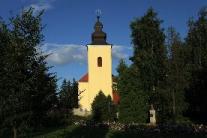You are here
Culture

Traditions and customs were lively parts of the everyday life in Mikóháza fifty years ago. The local community has created its own social rules, which have been handed down to the younger generations. These rules regulated the process of the several works, the ways of the social contact, lifestyle and the ways of the celebration. Most of these social rules have been preserved by the older generation of the community. Folk tradition was practised and saved by the members of the “Mikóházi Népi Együttes” (Folklore Company of Mikóháza) for almost two decades.
 “Gyöngyösbokréta” was the name of a theatrical performance, which was organized in Budapest every year from 1931 to 1944 on 20 August. Folkdance, folk music, plays were performed here by peasant companies. A very important cultural movement linked to this programme too, which had a great part in preserving the traditions. This movement was also the cradle of the Hungarian folkdance movement.
“Gyöngyösbokréta” was the name of a theatrical performance, which was organized in Budapest every year from 1931 to 1944 on 20 August. Folkdance, folk music, plays were performed here by peasant companies. A very important cultural movement linked to this programme too, which had a great part in preserving the traditions. This movement was also the cradle of the Hungarian folkdance movement.
A social organization was established by the companies in 1935 called “Bokréta
Szövetség”, later it was called “Magyar Bokréta Szövetség”. This association organized folk performances and managed the several member companies. It worked for more than 100 member companies and 4000 members. The first performance was initiated by Budapest, and this city remained the most important sponsor of this cultural programme for long years. The leader of the movement was Béla Paulini, who had a great importance in the organization. He used to be a journalist and he became the leader figure of the folklore movement at the age of 50, after several literary and theatrical works. He could gain the support of the government with his political and social views. The “Gyöngyösbokréta” performances and movement got a large publicity and they helped the presentation of the tradition in an authentic way.

Mikóháza was also a member of “Gyöngyösbokréta” movement. The group of Mikóháza performed a very kind tradition, the wedding of an orphan girl. The bride was walking in her white wedding gown, wearing white wedding wreath on her head. She was followed by her bridesmaids. The two bridesmen were walking beside the bride, decorated with embroidered scarves. One of them was holding a flag too, made of green branch and colourful scarves. The company was singing cheerful wedding songs.
The story was performed by the sons and daughters of János Mikulka, the former headmaster of the local school. Mikóháza was the only Greek Catholic village in the “Gyöngyösbokréta” movement.
Beside the wedding performance the company also performed a nativity play, several folk songs, czardas dance and several traditional male and female dances.  The company was established by Sándor Pataki, who arrived at the village on 15 August 1949 to work as the new postmaster. He recognised immediately the great value of the local traditions, folk music and folkdance. He became the art director of the company studying hard and teaching. Supported by his wife he helped the local culture with his tireless work and brilliant skills. The company worked with the local traditions, they performed a wide variety of local songs, dances and plays.
The company was established by Sándor Pataki, who arrived at the village on 15 August 1949 to work as the new postmaster. He recognised immediately the great value of the local traditions, folk music and folkdance. He became the art director of the company studying hard and teaching. Supported by his wife he helped the local culture with his tireless work and brilliant skills. The company worked with the local traditions, they performed a wide variety of local songs, dances and plays.
 Beside the female choir and solo singing local folkdances were the most popular. These dances could be learnt easily even by the youngest children and they showed a wide variety. The plays provided a great opportunity for the members to show their talent in playing drama, too.
Beside the female choir and solo singing local folkdances were the most popular. These dances could be learnt easily even by the youngest children and they showed a wide variety. The plays provided a great opportunity for the members to show their talent in playing drama, too.
The company lived its high times at the beginning of the 60s. They achieved the highest level with both their musical and their theatrical productions. Sándor Pataki got the award “For the Socialist Culture” on 3 June 1962 and the company also won a similarly prestigious award that year in August. They were over their 250th performance in 1965 and they had been almost everywhere in Hungary. They had had shows in the “Dunántúl”, five times in Budapest, in Szabolcs-Szatmár County and in its own county. Unfortunately, their art director got into hospital because of his health problems in 1967. By the time he recovered the successful company ceased in 1967.

According to Mr Pataki the reason of this end was sociological. A wave of the social mobility reached the village at the end of the 60s. The generation, which was socialized with a traditional peasant background, was getting older but the younger generation did not want to follow this old lifestyle. This runaway from the peasant traditions was helped by the company too, because the new
impressions could broaden the members’ perspective. The village could offer only a limited life-carrier for them. When the young people started to look for work or school they were scattered everywhere in the country.
“Everything should be started and finished just in time” – said Mr Pataki. – “We have started it just in time... The changing times have finished it for us.”
Mikóháza and the members of the company will never forget their favourite “Sanyi bácsi”– Mr Pataki.














